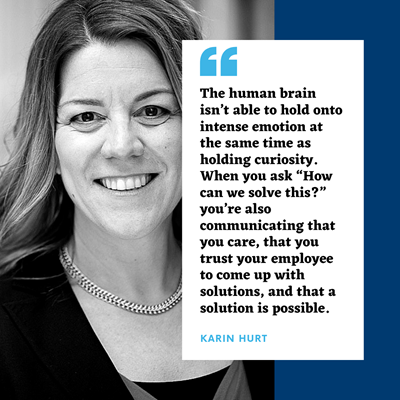By
Karin Hurt
|
Date Published: March 13, 2019 - Last Updated December 03, 2019
|
Comments
If you’ve worked in contact centers for any period of time, you’ve seen
your fair share of workplace drama: the
emotional responses to feedback;
the fire-drill frustrations; and perhaps even a few love triangles that
would make Jerry Springer’s hair curl.
Drama eats your productivity and can destroy the agent and customer
experience. When agents are emotionally frustrated, it’s nearly impossible
to smile through the phone and bring the empathy needed to really serve the
customer. When a supervisor is upset, they’re thinking out of the
fight-or-flight part of their brains, and it’s difficult for them to see
even the most obvious solutions.
Although you can’t eliminate the drama, you can learn ways to de-escalate
it and re-focus your team on what matters most.
7 Steps to Stop the Drama
1. Ground Yourself
You won’t be effective if you’re swept up and washed away in the storm of
other people’s drama. Anchor yourself.
Know what matters most
,
build connections
that keep you centered, steep in the values you want to live, and approach
each situation with a positive “we can solve this” attitude.
At the same time, be prepared for problems. After all, emergencies and
disruptions are par for the course in contact centers.
When everyone else is running around with their hair on fire, your grounded
energy will help your team to maintain their composure and focus. Your most
important jujitsu move here is to stay calm yourself and avoid feeding
their emotional response with your own.
2. Set Clear Expectations
Just as you
ensure everyone is on the same page
regarding key business outcomes, you want to set expectations around how
the team will react to challenges, how they resolve disagreements, and what
to do when someone lets you down.
Train your team on the
art of the tough conversation.
Talk about how the team will respond when (not if) there’s a problem.
Rehearse. Practice. Role-play and be ready. You’ll prevent problems from
catching fire and blowing up into unproductive drama. This
technique
can help.
These first two steps help you prepare for drama-situations before they
happen. Now let’s look at what to do when the drama happens:
3. Acknowledge Their Feelings / Concern
When someone is fired up, one of the most effective ways to de-escalate the
situation is to reflect how they’re feeling. For example, “It sounds like you’re
frustrated.”
You’re not telling them how to feel or saying you agree with their
interpretation. You’re just letting them know you understand how they are feeling.
Until that strong emotion is acknowledged, you’re unlikely to be able to
move forward. Often, this acknowledgment and understanding is all the
person needs.
4. Ask Rational Clarifying Questions
After you acknowledge their feeling, your next goal is to get the problem
into perspective. Ask straightforward questions that help quantify the real
issue.
For example, when someone comes to you wound up because “I’m facing an
insurrection! Everyone is fighting the new system, and this will never
work!” you might ask: “Who is having a hard time?” “What are they finding
challenging?”
It’s one thing for the world to be on fire, but it’s another when it’s just
Liz in Workforce and one OM who haven’t figured out how to get the data
they need.
Push for the specifics that define the real problem (not the emotional
problem).

5. Redirect to “How Can We” Questions
Once you’ve got the problem identified, asking a “How can we?” question
helps pull the person out of reacting and into problem-solving. The human
brain isn’t able to hold onto intense emotion at the same time as holding
curiosity.
When you ask “How can we solve this?” you’re also communicating that you
care, that you trust them to be able to come up with solutions, and that a
solution is possible. That’s a lot of drama-erasing, problem-solving power
for one short question.
6. Identify Next Steps
As they come up with solutions, translate those into specific actions that
can be taken (the sooner, the better). Ideally, these are actions they can
take to help solve the issue. Sometimes there will be steps for you to take
as well.
Either way, don’t allow the situation to resolve without specific
commitments to action.
7. Finish Strong
Schedule a specific time where you and the other person will meet to review
the actions both of you have taken, their impact, and what comes next. This
is a critical step that prevents this particular dramatic situation from
happening again. Don't waste this conversation. If you do, the drama will be
back before you know it.
Finish strong
.
Your Turn
When you use these seven steps, you’ll prevent unnecessary drama. Your team
will have the tools to deal with problems productively. For team members
with a more drama-loving personality, walking them through steps 3 – 7 will
guide them to more productive behaviors.
We’d love to hear from you:
what’s your best tip to stop the drama, calm things down, and help
everyone focus on moving forward?